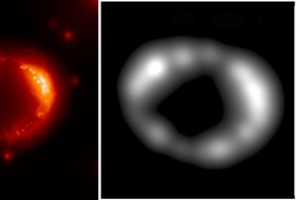Heating due to shocks traveling in the supernova remnant SN 1987 A

Shock waves are ubiquitous phenomena in astrophysics, occurring in a long list of different environments, from our Solar System to extragalactic and cosmological scales. Astrophysical shocks are particularly important since they occur in extreme conditions which can not be observed or reproduced on Earth. For instance, In the atmosphere of our planet the heating due to a traveling shock wave is due to collisions between gas molecules. Astrophysical environments are instead low-density and thus collisions can not be an efficient heating process. In these environments, thus, the heating due to shock waves are instead due to fluctuations of the electromagnetic field or to waves traveling in the plasma (which is the typical state of astrophysical matter). The understanding of these heating mechanisms is crucial to comprehend how the interstellar matter is affected by incident shock waves.
On February 1987 a supernova exploded in the Large Magellanic Cloud. This was the only existing case where astronomers could observe the supernova explosion, identify the progenitor, and follow the formation and evolution of the supernova remnant (SN 1987A) with most of the available large telescopes. SN 1987 A is also an ideal target to study shocks in astrophysical environments, given the high velocity of the shock and the brightness of the shocked region of the supernova remnant.
In the study “Collisionless shock heating of heavy ions in SN 1987A” of M. Miceli (Phisics Department of the University of Palermo and Inaf – Astronomical Observatory of Palermo), recently published by Nature Astronomy, SN 1987A is analyzed in order to study the heating induced by the propagating shock wave. Thanks to observations in X-rays made with the Nasa satellite Chandra and a model describing the supernova remnant and its evolution from the formation to present days (developed using the supercomputing facility MareNostrum III in Barcelona as part of the European supercomputing project Prace), the authors have demonstrated that the temperature of the ions reached by the shock wave depends on their mass. This does not occur on Earth environments. The heating of the ions up to few hundreds million degrees is due to the non-collisional shock waves produced by the supernova explosion and traveling in the supernova remnant. The astronomers Salvatore Orlando and Fabrizio Bocchino (INAF-OAPA) and Giovanni Peres, Fabio Reale, and Costanza Argiroffi (UNIPA) are coauthors of this study.
The study has been widely reported by media, both in Italy (the Inaf web portal, Le Scienze, Global Science and local newpaper such as “La Sicilia” and “Il giornale di Sicilia”) and abroad (Phys.org, Science Daily, Space Daily, Tech Times, Sky Nightly, and Space Ref. ). The paper is also the fourth article published on Nature Astronomy for online attention, attending the statistics provided by journal about the published articles.
The figure (link) shows a synthesized emission map of the shocked supernova remnant
